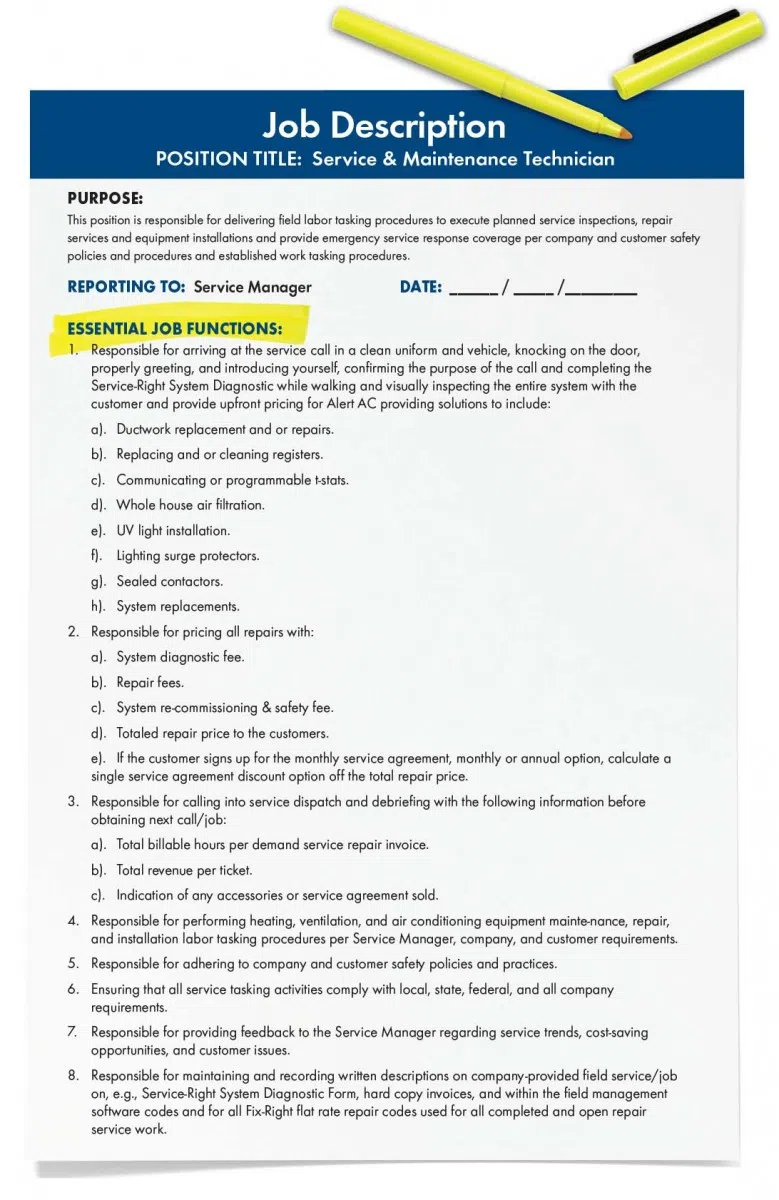This is the second installment of a six-part series designed to be a complete A-Z on how to sell and organize for commercial service agreements. The Selling Commercial Service Agreements series includes the following topics:
- Preparing for service agreement surveys
- Equipment and system surveying and data gathering
- Profitable pricing strategies to win the business
- Proposal writing strategies
- Hiring and compensating sales service sales reps
- Organizing for service agreements
Part II: Equipment/System Surveying and Data Gathering
The main objective when you perform an on-site commercial service agreement survey is to look for opportunities that match your company's capabilities and offerings with the unique financial and technical needs and wants of your prospect. You do this by gathering information about the prospect's requirements and the technical scope of work requirements.
The unique set of services you will propose (along with estimated cost) should be based on the technical information you gather. The costs themselves depend on the equipment size, usage, accessibility, special services, and — if you are covering any repair or replacement of component parts — hours of operation, age or warranty status.
The business information you gather involves the financial-transaction part of delivering your services and how you will communicate performance or share in any business risks associated in the delivery of your services.
If you don't do a good job of gathering the technical information, your firm could over price or under price its services, which could cause you to either lose the job or lose money on the job. If you don't do a good job of gathering the business information, you could fail to properly obtain and communicate in your proposal what both parties are expecting, and one or both parties likely will not be satisfied.
Systematic Information-Gathering Process
We recommend the following systematic information-gathering process to obtain both the technical and business-related information you will need.
Meet with the prospect to obtain their business transaction requirements:
- What are his mechanical-maintenance objectives?
- When and how must you communicate performance?
- What security or accessibility issues must be addressed?
- What are his pricing requirements or what strategy must you use to win the business? Pricing could be based on any or all of the following:
- The prospect's budget requirements.
- The competition and how they are serving them now.
- The transaction terms and conditions expectations.
- Where is the bill-to location?
- Where is the actual work location(s) where you will deliver your services?
- Will the facility make any future changes to that could affect equipment hours of operation, loading, replacements, and space? (This could mean additions that could require agreement adjustments for equipment adds or deletions.)
- What are his emergency service response requirements?
- Can or will the owner/operator provide portions of the services (e.g., filter removal and disposal, condenser head removal, tube punching, etc.)?
- Survey the facility and equipment to obtain technical transaction requirements:
- Where is the equipment located?
- Is the equipment accessible?
- What are the equipment-maintenance tasking requirements?
- What are the required equipment tasking skill level requirements?
- What is the required or recommended maintenance tasking frequency?
- Is there a requirement to perform maintenance tasking during off-hour periods?
- What are the equipment component repair and replace liability factors? Such as:
- Equipment age? The older the equipment, the more likely of failure.
- Operating hours? Operating above normal means the equipment is more likely to fail. For example: Packaged units normal office operation 12 hours/day; cooling or heating only are seasonal operation; under capacity equipment will run above normal design. Equipment used in unusual applications such a split system cooling only used for constant loads (e.g., computer rooms or process cooling).
- Is there any equipment under manufactures warranty? Units that are under whole or partial warranty reduce your liability coverage costs.
- Is there equipment with multiple compressors? The estimating tables are based on one compressor system. Multiple compressors increase repair and replace risk by 20%.
- What are the emergency overtime coverage periods (e.g., none, M-F, M-S)? The repair labor has to be adjusted to cover overtime costs.
- Is there any equipment that has difficult accessibility? For each inspection visit you need to add time to get to that individual piece of equipment.
- Are there unique filter sizes and change frequencies? If so, obtain or create a filter schedule.
- Are there any special services requirements, such as:
- Water treatment
- Eddy current testing
- Vibrations analysis
- Oil analysis
- Tube punching
- Summer/winter switchover
- Daily, weekly, monthly mechanical watch tours
- Are there any subcontracted services (e.g., water treatment)?
- Are there any special tools or equipment rentals (e.g., lift, gantry, etc.)?
- What is the distance from the trade labor start point to the actual work location?
- Is parking available or do you have to cover parking costs (e.g., traffic tickets per visit)?
- Is the facility accessible to your trade labor to get to equipment under your service agreement, or will it require access delays (e.g., prison security checks)?
No matter the type of facility, an on-site equipment and system survey is required. Simply taking an equipment list to estimate and propose a service agreement eliminates your opportunity to find ways to differentiate your offering from the competition. If you fail to do this differentiator search, then you give the prospect no real reason to take a chance on switching to your company.
Although it is a good idea to obtain the facility mechanical plans as a standard practice, it may be necessary for some complex or multi-building facilities to obtain the building plans in order to identify the exact quantity and locations of equipment. For new buildings for which you plan to propose your services, I recommend that you do so before the construction is a third of the way completed. The best place to obtain system and equipment data is in the building plans.
Conducting the System/Equipment Survey
You will find that most units of HVACR equipment have nameplates, which contain the equipment?s make, model, year built, and capacity (size). In some cases, these nameplates have been removed by an unscrupulous competitor or are badly faded due to sun damage or other factor. For these, you may need to identify equipment information on the facility mechanical plans; or you can use the equipment components to identify its capacity or size. For example:
- Air handler units and fans: Identify size via fan motor horsepower rating.
- Reciprocating cooling systems (packaged rooftop units, chillers, split systems): Identify size via compressor horsepower rating.
You will find that in some cases you may have the make and model numbers but not the capacity or size information. The best way to obtain the capacity or size information is by contacting the manufacturer. Most manufacturers have websites where recent models of equipment are available. We recommend that you develop a manufacturers' reference library of product cut sheets to quickly obtain data for older equipment.
Where you start the building surveys depends on the building type and or its design complexity. Since 90% of all commercial buildings use packaged rooftop equipment, you will usually start at the roof and work your way down to the lowest level.
For multi-facility or multi-story facilities, the mechanical rooms or central plant areas are logical starting points. Starting at the central mechanical provides the salesperson with a better picture on how the conditioned air and or water is being distributed throughout the facility(s). Having an understanding of how the HVACR system is laid out enables the salesperson to look for and ask pertinent questions related to system operating and maintenance tasking requirements.





